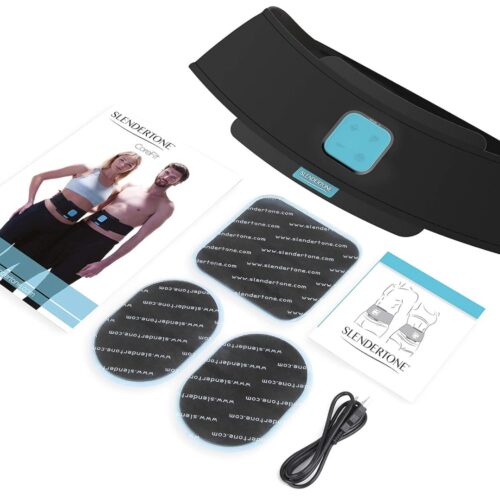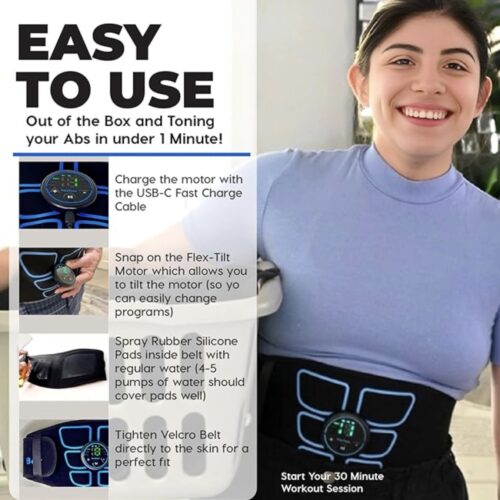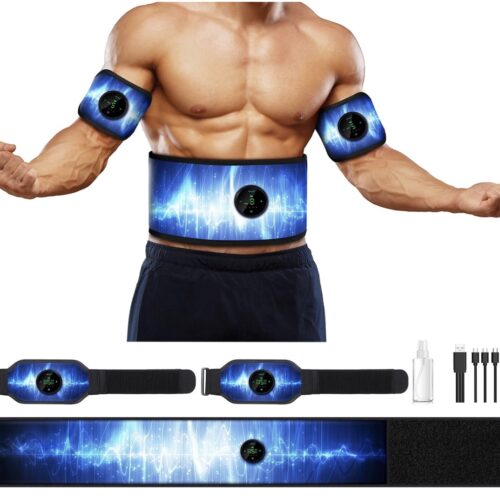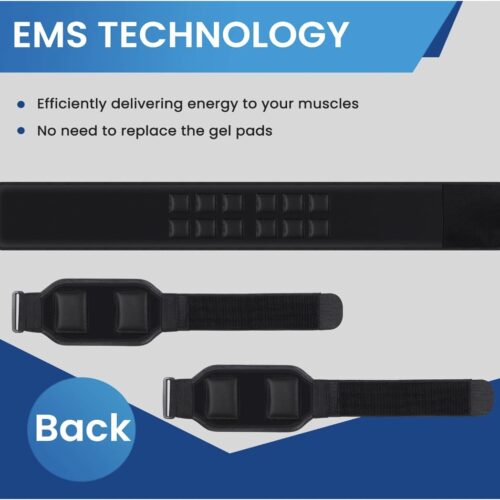Keeping your muscles strong is key to feeling young as you age. Muscle wasting, which happens as you get older, contributes to frailty and increases the risk of death from various causes.
Exercise, particularly resistance training, is the best way to maintain muscle strength. Starting exercise later in life is still beneficial, but it can be challenging for those who have already lost muscle mass.
Electrical muscle stimulation (EMS) is a technique that might help strengthen muscles without requiring physical activity. But does it really work? And can it benefit even young, healthy people? Let’s find out.

What is EMS?
EMS, short for Electrical Muscle Stimulation, is a type of electrotherapy that uses electric currents to boost muscle function. It’s also known as neuromuscular electrical stimulation (NMES) or electromyostimulation.
Electronic muscle stimulators (EMS) send electrical signals to make your muscles contract. They’re commonly used in physical therapy and rehab.
Physical therapists have been using this method since the 1960s to help patients build and keep muscle strength after surgery. In the past, elite athletes in the former Soviet Union saw big improvements in strength—up to 30% to 40%. This suggests that EMS might be even better than just regular exercise.
During electrical myostimulation, electrodes are placed on the skin above the muscles, and a current is sent from a battery to the muscle. This prompts muscle contractions, which, when done regularly, could lead to increased muscle strength.
Learn MoreHow Do Muscle Stimulators Work?
In electrical muscle stimulation (EMS), three main types of electric currents are used:
- Direct current (galvanic)
- Alternating current (biphasic)
- Pulsed current (pulsed AC and DC).
Each type serves slightly different purposes in electrotherapy.
These currents cause muscle contractions, which can vary in speed and duration. Some contractions are quick and frequent, while others involve rapid contractions followed by longer pauses, or sustained contractions held for several seconds or even minutes.
Normally, your body activates muscles by sending electrical impulses from your brain through your central nervous system (CNS). However, an EMS device allows you to experience deep, intense muscle contractions without directly engaging your CNS, as well as without stressing your joints and tendons.
While it might seem like a way to work out without moving, studies show that EMS works best when used alongside targeted exercises. This is because while you’re engaging your slow-twitch muscle fibers consciously, the machine is activating the fast-twitch ones.
With all muscle fibers contracting rapidly, just two 20-minute sessions per week can bring noticeable results over a few weeks.

Who is EMS For?
EMS serves various purposes, catering to different needs. Here are the types of people who are suitable to use EMS:
- Patients recovering from neurological injuries: EMS, especially in the form of functional electrical stimulation (FES), can help regain movement control after neurological trauma by generating specific muscle motions.
- Those undergoing rehabilitation after surgery: EMS assists in preserving muscle function during periods of extended disuse, such as postoperative recovery.
- Older adults looking to maintain or improve muscle strength: EMS can be used alongside exercise or as an alternative for those unable to engage in traditional exercise due to health limitations.
- Healthy people seeking muscle gains: EMS can complement regular exercise routines, particularly for targeting specific muscle groups and enhancing strength gains.
- Anyone interested in weight loss: EMS increases calorie expenditure through muscle stimulation. This might help with weight loss efforts, especially when combined with a balanced diet and regular exercise regimen.
Benefits of EMS
- Improves muscle strength: EMS can yield results comparable to several hours of vigorous activity in just a single 25-minute session. It’s an efficient option for enhancing general strength and body composition.
- Weight management: With EMS, you can achieve benefits similar to 4 hours of sports in just one 25-minute session, making it a time-efficient option for weight management.
- Perfect for muscle recovery: EMS improves circulation and helps flush out lactic acid, reducing muscle soreness after workouts and accelerating recovery.
- Improves sport performance: Professional athletes use EMS to enhance strength, endurance, and recovery.
- Improves range of motion: EMS trains all major muscle groups, promoting a full range of motion essential for targeting muscles effectively and reducing the risk of injury.
- Simple and easy to do: EMS provides a straightforward alternative to traditional workouts. It delivers comparable results without the complexity of gym equipment.
- Reduces muscle cramping: EMS can effectively decrease muscle cramp frequency, offering relief to people prone to regular cramps.


Potential Risks
When it comes to electrical muscle stimulation, there are few risks involved. The most common issues include tissue burns and skin irritation.
However, problems can arise if the electrodes are placed too close to a transdermal drug patch.
Electrical muscle stimulation might not be suitable for everyone. Doctors may advise against it for individuals who:
- are pregnant
- have implanted pacemakers
- have epilepsy
Is EMS Backed By Science?
Yes, EMS has been scientifically proven to stimulate muscle growth in many studies. There are different theories explaining how EMS contributes to muscle strengthening.
One theory suggests that when you fully contract a muscle, only 30% of its fibers are activated, leaving 70% dormant. EMS could potentially activate these inactive fibers, especially beneficial for muscles that are very weak or struggle with typical activities.
Another mechanism of EMS involves enhancing nerve conduction rates. Normally, your brain needs about 10,000 repetitions to efficiently transmit signals to muscles. EMS may help accelerate this learning process by providing repeated contractions, improving your body’s ability to activate muscles swiftly.


How to Use EMS for Abs?
While EMS can strengthen and tone your abs by causing muscle contractions, don’t expect a six-pack from daily use alone. The FDA states there’s no proof EMS alone will give you those chiseled abs from TV ads. Diet and exercise remain key.
Not all EMS units are created equal for muscle strengthening and toning. They vary in intensity, from one to 130 megahertz, focusing on improving blood flow and reducing inflammation.
For home use, there are ab stimulator belts and personal-sized units with electrodes you can place on your abs or other muscles.
Here’s how to use an ab stimulator:
- Install Batteries: If your ab stimulator uses batteries, follow the manual’s instructions to install them properly. You may need a screwdriver to access the battery compartment.
- Clean Your Skin: Wash the area where you’ll apply the ab stimulator with soap and water, or wipe it with rubbing alcohol. Make sure your skin is dry before proceeding.
- Attach Gel Pads: Wash your hands before handling the gel pads. Peel off the backing and apply them to the electrodes on the device, ensuring they’re centered and properly aligned.
- Position the Stimulator: Place the ab stimulator on your abdominal muscles, aligning the gel pads directly over them. Press the pads onto your skin firmly but gently.
- Start at Low Intensity: Begin with the lowest intensity setting, especially if it’s your first time using the device. Sit down for stability before turning it on to avoid being caught off guard by the muscle contractions.
- Limit Session Time: Use the stimulator for 10-12 minutes per session to prevent cramps and skin irritation. After each session, wipe down the pads and store the device as directed in the manual.
- Gradually Increase Intensity: Increase the intensity gradually every 5 to 10 sessions to avoid shocking your muscles. Even if you’re in good shape, starting at a low intensity is safest.
- Combine with Exercise: For best results, incorporate ab stimulator sessions into your regular exercise routine. Cardio workouts, in particular, can complement the effects of the stimulator and help tone your midsection.
Our Ab Stimulators
Our ab stimulators are scientifically proven to work and endorsed by personal trainers. You can use the stimulators anytime and anywhere, making it easy to keep up with your training routine. Regular use of the ab stimulators is key to seeing fast results.





